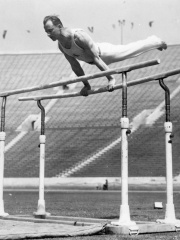

The Most Famous
GYMNASTS from Finland
This page contains a list of the greatest Finnish Gymnasts. The pantheon dataset contains 370 Gymnasts, 2 of which were born in Finland. This makes Finland the birth place of the 34th most number of Gymnasts behind Ireland, and South Africa.
Top 2
The following people are considered by Pantheon to be the most legendary Finnish Gymnasts of all time. This list of famous Finnish Gymnasts is sorted by HPI (Historical Popularity Index), a metric that aggregates information on a biography's online popularity.

1. Paavo Aaltonen (1919 - 1962)
With an HPI of 60.21, Paavo Aaltonen is the most famous Finnish Gymnast. His biography has been translated into 20 different languages on wikipedia.
Paavo Johannes Aaltonen (11 December 1919 – 9 September 1962) was a Finnish artistic gymnast and a three-time Olympic champion. At the 1948 Summer Olympics, he won four medals, of which three were gold, including a three-way tie for gold in the pommel horse with teammates Veikko Huhtanen and Heikki Savolainen. He also competed at the 1952 Summer Olympics, winning a team bronze for a total of five Olympic medals during his career. At the 1950 World Championships, Aaltonen won the gold medal on the horizontal bar and the team silver medal.

2. Heikki Savolainen (1907 - 1997)
With an HPI of 59.27, Heikki Savolainen is the 2nd most famous Finnish Gymnast. Her biography has been translated into 21 different languages.
Heikki Ilmari Savolainen (28 September 1907 – 29 November 1997) was a Finnish artistic gymnast. He competed in five consecutive Olympics from 1928 to 1952 and won at least one medal in each of them. In 1928, he won a bronze on pommel horse, which was the first-ever medal in gymnastics for Finland. Winning his last medal at the 1952 Summer Olympics in Helsinki, he became the oldest gymnastics medalist, at 44 years old; he delivered the Olympic Oath in the opening ceremony of the 1952 games. In 1932, Savolainen and his teammate Einari Teräsvirta had the same score on horizontal bar, but the Finnish team voted to give the silver medal to Savolainen. In 1948, he again had the same score as teammates Veikko Huhtanen and Paavo Aaltonen on pommel horse, and the gold medal was shared among the three. Additionally, he competed at the 1931 World Artistic Gymnastics Championships where, although he was the first-place finisher in the all-around combined exercises, he was not termed "world champion" because there was a special clause to the rules that in order for any individual to be properly termed 'World Champion', they had to demonstrate a certain level of competency among all 14 events, scoring at least 60% of all of the points that could be possibly awarded on each event, which he did not do. Nevertheless, he did win an individual gold medal at those 1931 Worlds on the horizontal bar apparatus. At the world championships, Savolainen won only one medal, a team silver in 1950. Domestically, he collected 20 titles between 1928 and 1950, including six individual all-around titles in 1928–37. Savolainen graduated as a physical education teacher in 1931, and a Doctor of Medicine in 1939, after which he started working as a doctor in his hometown Kajaani, Finland. During the Winter War he served with the rank of lieutenant colonel as the head doctor in a military hospital. In parallel, Savolainen worked for the Finnish sports magazine Urheilulehti in 1932–37. From 1946 to 1959, he served as vice-president of the Finnish Gymnastics Federation, and in 1946–56 as president of gymnastics federation of Kajaani, the town where he lived most of his later life. Savolainen is the only Finnish gymnast inducted into the International Gymnastics Hall of Fame (2004).
People
Pantheon has 2 people classified as Finnish gymnasts born between 1907 and 1919. Of these 2, none of them are still alive today. The most famous deceased Finnish gymnasts include Paavo Aaltonen, and Heikki Savolainen.

